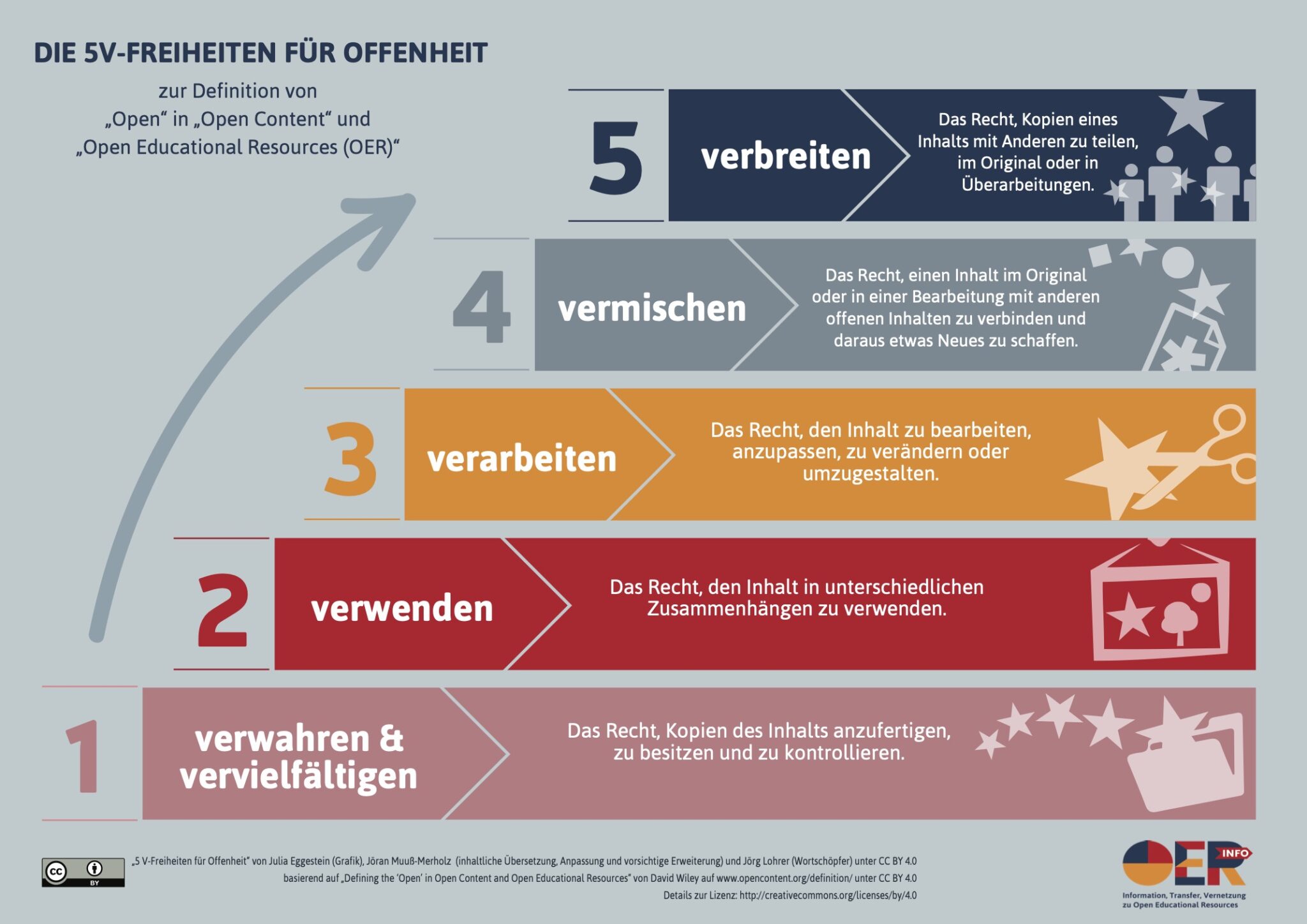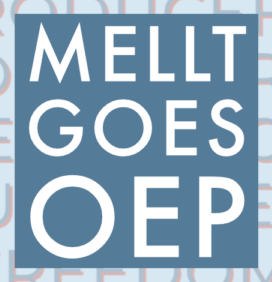What actually is OER?
Open Educational Resources (OER) generally refers to educational content that is available under free licenses (often Creative Commons (CC) licenses) or is marked as being in the public domain.
The term was first used by UNESCO in 2002 in a forum on higher education in developing countries(UNESCO, 2002: 24). The basic components of OER are free access, the possibility of adaptation and dissemination via the Internet (ibid.). To ensure that teaching and learning materials can be disseminated under these conditions, research is attempting to define the openness of resources, i.e. the term open, more precisely: Wiley formulates the 5R-Rules for this purpose, which is the most commonly used practice-oriented definition (Wiley, Bliss & McEwen, 2014: 782; Wiley & Hilton, 2018: 134-135). In German, these are translated as the 5V rules (see 5V graphic).

OER must first be allowed to be stored and reproduced.
According to Section 60a (1) and (2) of the German Copyright Act (“UrhG”), teachers have various options for using protected materials for teaching purposes, but are limited to their educational institution.
The materials may therefore only be made available to their own students, teachers at the same school, examiners or lesson observers.
Publication is therefore not permitted.
The second rule of use is based on the same conditions.
Even if teachers are granted many freedoms by the Copyright Act, OER should be able to be used in full and also in other contexts.
The third V requires the possibility of processing the resource.
According to Section 23 of the Copyright Act, no further processing of protected works is permitted without the consent of the author.
Such consent is granted by CC licenses (unless the license contains the designation ND for “non-derivative” = no changes permitted) and for products marked as public domain.
This permission is particularly important because it may be necessary to translate OER into other languages, to correct them or to adapt them to your own teaching content.
The fourth point is that OER should be allowed to be mixed.
On the one hand, this involves combining the material with other OER and supplementing its content in order to create more targeted learning arrangements.
On the other hand, blending offers the opportunity to create entirely new resources that, through republication, represent the inherent core of OER-enabled pedagogy, as proposed by Wiley and Hilton (2018): materials are free and reach many learners and teachers.
This is considered to be achieved above all in combination with the last V, the so-called …
… dissemination.
This is the basic idea behind OER, because the resources should be allowed to be shared and distributed in their original and modified state in order to reach as many people as possible.
If these requirements are met, teaching and learning materials can be described as OER.
They can be used independently of educational institutions, i.e. in both formal and informal educational contexts, as well as for independent learning.
They can appeal to pupils, but also to students, workers, trainees, teachers at various institutions or anyone interested in learning.
OER should make education accessible and possible for everyone.
In order to be able to use learning resources as openly as possible, it is necessary to deal with their licensing.
Everyone has probably come across the copyright symbol (©).
This indicates to consumers that the right to a symbol, photo, word, product or generally to works based on work and creativity lies with a legal entity.
However, you do not have to protect something you have created through complex and cost-intensive processes.
In Germany, there is the so-called Copyright Act (UrhG).
Section 1 states: “Authors of literary, scientific and artistic works shall enjoy protection for their works”.
Even if most people would not initially describe their vacation photos as ‘works of art’, this law includes any “personal intellectual creation[s]” (§ 2, paragraph 2).
So if photos are taken, photographers have the rights to them.
They can therefore also publish it.
Others are then initially not allowed to redistribute the photo unless they have the consent of the rights holder (§ 31).
However, since OER should be accessible and usable for the general public, licenses are needed that meet the 5-R rules (see above) as far as possible.
Various so-called free or open licenses offer possibilities for this:
The most common here are Creative Commons (CC) licenses(https://creativecommons.org).
CC licenses can be created quickly and free of charge on the relevant website.
You can either read up on the content and possibilities of the individual licenses or use an online tool that uses a few questions to suggest the appropriate license for the intended use or release.
This license must be created once and does not lose its validity.
There are a total of seven CC licenses, which are considered to be of varying degrees of openness.
There is no consensus on the point at which the open in OER is no longer given.
However, you can test your license against the freedoms already mentioned (see “The 5V freedoms”).
CC0 is a license that identifies a product as public domain, i.e. in the public domain.
It may then be used without conditions.
The possible freedoms are then graduated.
CC-BY offers the same possibilities for further processing, but requires that authors are named.
The other licenses gradually restrict further processing.
CC BY-SA(SAmelicense) requires, for example, that if the original product is modified and published under this license, the new product must be shared under the same license; CC BY-NC prohibits commercial reuse(NonCommercial); and CC BY-ND prohibits the modification of the product, it may only be redistributed in its original state(No Derivatives).
Two further licenses combine the above-mentioned restrictions, the sense of which is shown accordingly: CC BY-NC-SA and CC BY-NC-ND.
Why are OER forward-looking for teaching?
Open Educational Resources (OER for short) are an important part of modern education. Through their targeted use in English lessons, traditional teaching and learning settings can be rethought and innovations stimulated. They break up the conventional linearity of the creation, distribution and use of teaching materials and thus offer a way of opening up teaching and learning processes in a variety of ways.
OER enable low-threshold access to alternative, digitally supported teaching materials with potentially broader content diversity compared to traditional textbooks. With regard to digitalization and the associated challenges, OER create a new teaching and learning infrastructure by making contemporary teaching materials widely accessible and adaptable in the interests of educational equity. Teachers and learners can not only take on the role of users, but also actively and collaboratively publish materials and products in the public domain and release them for use and adaptation. In this context, the Five Freedoms of OER, developed under the leadership of David Wiley (2014), are characteristic.
These new opportunities for participation through OER are important for both learners and teachers: engaging with OER and the associated use, testing and adaptation of externally created material represents an important key competence in the professionalization of teachers and promotes professional exchange among teachers beyond the boundaries of their own school. OER are particularly important for students in view of the growing importance of media skills. For them, OER offer, among other things, new, digitally supported task formats that need to be used and critically evaluated in terms of media literacy. In addition, OER can play a key role in performance differentiation, as they give students the opportunity to exercise their right to education in a way that is adapted to their own needs outside of formal learning spaces.

